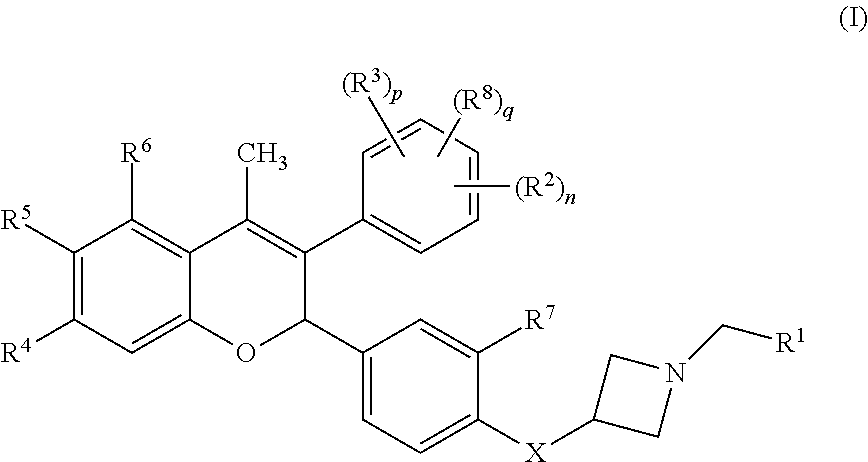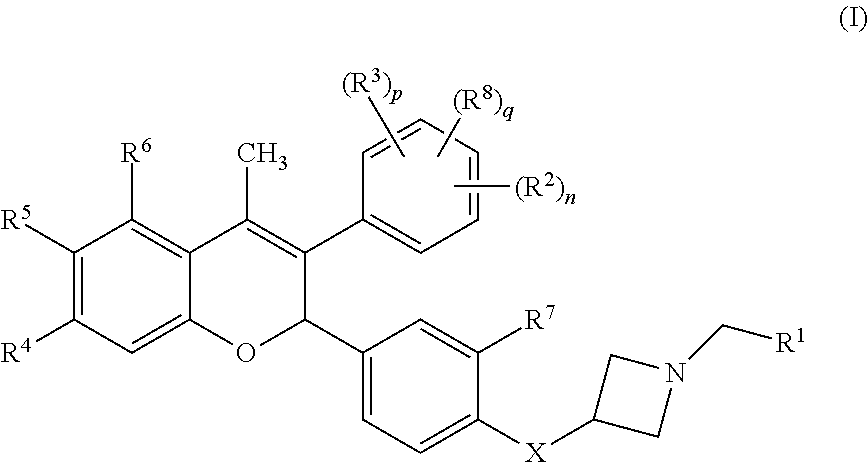Anti-estrogenic compounds
a technology of estrogen and compound, applied in the field of pharmaceuticals, can solve the problems of drug not working in pre-menopausal women, poor oral bioavailability, and unclear whether these two injections provide sufficient drug exposure for optimal action, and achieve the effect of reducing the risk of recurrence and preventing breast cancer
- Summary
- Abstract
- Description
- Claims
- Application Information
AI Technical Summary
Benefits of technology
Problems solved by technology
Method used
Image
Examples
example 1
Preparation of 3-(4-hydroxyphenyl)-4-methyl-2-(4-((1-propylazetidin-3-yl)methyl)phenyl)-2H-chromen-7-ol (Compound 101)
[0178]
Step 1: Preparation of 2-(4-((1-propylazetidin-3-yl)methyl)phenyl)-7-((tetrahydro-2H-pyran-2-yl)oxy)-3-(4-((tetrahydro-2H-pyran-2-yl)oxy)phenyl)chroman-4-one
[0179]
[0180]1-(2-Hydroxy-4-((tetrahydro-2H-pyran-2-yl)oxy)phenyl)-2-(4-((tetrahydro-2H-pyran-2-yl)oxy)phenyl)ethanone (1.594 g, 3.9 mmol, 1.1 equiv.) was added to a 100 mL three-neck flask. 2-Butanol (30 mL) and the product of Preparation 4, 4-((1-propylazetidin-3-yl)methyl)benzaldehyde (0.80 g, 3.7 mmol, 1.0 equiv.), were added to the flask to provide a suspension. Piperidine (0.36 mL, 3.6 mmol, 1.0 equiv.) and DBU (0.36 mL, 2.4 mmol, 0.7 equiv.) were added to the mixture to provide a white suspension. The flask was fitted with a Dean-Stark trap and condenser and heated in an oil bath at 130° C. The white suspension became a light yellow solution when the temperature reached 65° C. Half the solvent (15 mL)...
examples 2 and 3
Separation of 3-(4-hydroxyphenyl)-4-methyl-2-(4-((1-propylazetidin-3-yl)methyl)phenyl)-2H-chromen-7-ol, Compound 102 (S-isomer) and Compound 103 (R-isomer)
[0188]
[0189]3-(4-Hydroxyphenyl)-4-methyl-2-(4-((1-propylazetidin-3-yl)methyl)phenyl)-2H-chromen-7-ol (0.060 g, 0.1 mmol) was dissolved into 2 mL of absolute ethanol. The solution was purified by preparative chromatography with 400 to 600 μL injections over 5 runs. Fractions of each peak were pooled and concentrated via rotovap separately to provide light yellow solids. The solids were dried under high vacuum at 50° C. for 2 days. Peak 1, Compound 102: 16.7 mg; Peak 2, Compound 103: 15.4 mg.
[0190]Analytical HPLC
[0191]Column: ChiralPak AD-H, 250×4.6 mm
[0192]Temperature: 25° C.
[0193]Flow: 1 mL / min
[0194]Solvent system: 20% denatured EtOH (90% EtOH, 5% IPA, 5% MeOH) in Hex with 0.1% DEA
[0195]Chiral Retention Times (minutes)
[0196]Peak 1, Compound 102: 5.51
[0197]Peak 2, Compound 103: 6.57
[0198]Purification on Preparative HPLC
[0199]Column...
example 4
Preparation of 3-(4-hydroxyphenyl)-4-methyl-2-(4-((1-propylazetidin-3-yl)oxy)phenyl)-2H-chromen-7-ol (Compound 104)
[0217]
Step 1: Preparation of 2-(4-iodophenyl)-7-((tetrahydro-2H-pyran-2-yl)oxy)-3-(4-((tetrahydro-2H-pyran-2-yl)oxy)phenyl)chroman-4-one
[0218]
[0219]1-(2-Hydroxy-4-((tetrahydro-2H-pyran-2-yl)oxy)phenyl)-2-(4-((tetrahydro-2H-pyran-2-yl)oxy)phenyl)ethanone (293.0 g, 0.71 mol, 1.0 equiv.) was added to a three-neck 5 L round bottom flask. 2-Butanol (1.25 L) and 97.0% 4-iodobenzaldehyde (169.9 g, 0.71 mol, 1.0 equiv.) were added to the flask to provide a suspension. Piperidine (23.5 mL, 0.24 mol, 0.3 equiv.) and DBU (36.4 mL, 0.24 mol, 0.3 equiv.) were added to the suspension. The flask was fitted with a Dean-Stark apparatus, a condenser, a thermometer with an inlet adapter, and a stir bar. The reaction was heated under a nitrogen atmosphere with a mantle to provide an orange solution at 78° C. Heating was continued to reflux. Half the solvent (610 mL) was collected over 1.5 ...
PUM
 Login to View More
Login to View More Abstract
Description
Claims
Application Information
 Login to View More
Login to View More - R&D
- Intellectual Property
- Life Sciences
- Materials
- Tech Scout
- Unparalleled Data Quality
- Higher Quality Content
- 60% Fewer Hallucinations
Browse by: Latest US Patents, China's latest patents, Technical Efficacy Thesaurus, Application Domain, Technology Topic, Popular Technical Reports.
© 2025 PatSnap. All rights reserved.Legal|Privacy policy|Modern Slavery Act Transparency Statement|Sitemap|About US| Contact US: help@patsnap.com



